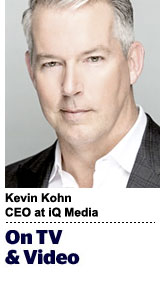 “On TV And Video” is a column exploring opportunities and challenges in advanced TV and video.
“On TV And Video” is a column exploring opportunities and challenges in advanced TV and video.
Today’s column is written by Kevin Kohn, CEO at iQ Media.
Today’s living room looks a bit different than it did in the 1960s, or even the 1990s, but its focal point remains the same: the television.
While cutting the cord on traditional broadcast is indeed a very real thing, TV has not lost its relevance as a meaningful source of content. The living room of today simply has a few more devices now than it did 50 years ago, making TV a more digital experience than ever before.
It’s also a more connected one. With dozens of over-the-top (OTT) devices, smart TVs and mobile devices and thousands of channels to choose from, advertisers have much more to think about than just reaching audiences and making an emotional connection. They must also ensure they make literal connections across devices and apply what they learn about their efforts on one device to their efforts on others.
All of this begs the question: Should TV be held to the same standards as digital video?
For online video marketers, viewability standards, in particular, are both a must-have and a work in progress. As things currently stand, viewability is an indication of whether an ad has the opportunity to be seen. But for TV advertisers, viewability will need to mean more than that. As TV viewership continues to shift online to OTT services and connected devices, audience measurement models need to evolve with it.
The TV industry has historically relied on a broad, viewership-based understanding of TV performance, so moving to viewability’s far more acute level of measurement would be no small undertaking. But this move has the potential to put TV in a position to influence the way digital channels are measured for the first time.
It’s important to start by establishing a clear understanding of both the problem and opportunity. TV advertisers currently base their ad decisions on the likelihood of being seen, among other things. But, new viewability standards could allow them to make far more informed decisions based on more granular variables, such as whether their ads are presented clearly enough to be understood and absorbed by viewers, and how this might influence the likelihood of audiences taking action.
These standards would need to account for traditional paid TV ads – 30-second, 15-second and maybe even six-second spots – as well as event sponsorships, product placement and even naming rights on certain properties. And they would need to recognize that while advertisers’ on-screen time and space is shrinking and shifting, their expectations for exposure and results remain just as ambitious.
A handful of metrics out there attempt to offer this type of clarity, but they have their shortcomings. Some measure mere logo appearances, but don’t account for whether the logo is completely presented on the screen and at a size that would be naturally detected by the human eye. Logo measurement also does not account for how much time the logo must be present for a passive viewer to absorb it, even on a subconscious level.
Other metrics simply detect where brand mentions or appearances fall within the program and are reported by time stamp, independent of quality. These metrics don’t provide any clearer understanding of whether the brand placement was worthwhile.
Without standards for “grading” these paid brand instances and classifying them according to visibility and completeness, advertisers remain unable to attribute value to their ads, and the industry as a whole has no unified understanding of good vs. bad, as far as viewable impressions go.
Discrepancies in measurement standards are not acceptable on any channel, but leaving TV out of the equation suggests a lack of industry foresight. The networks, agencies and advertisers must be on the same page, with viewability measurement reported alongside reach and frequency.
The opportunity is great. Cracking the viewability code for TV could answer lingering questions for digital and put TV in a position to influence other channels. The largest opportunity would be for TV to take the reins and lay the groundwork for unified viewability standards across all channels, reflecting that advertisers, like their audiences, want to move freely between many channels.
Finally, the industry must create a universally accepted method of measurement. The GRP is an excellent source of understanding how many were reached and how much they were shown an ad, but it will never be able to answer whether TV ads were seen and understood. And it certainly won’t move beyond TV to answer the question the industry doesn’t yet dare to ask: How might this ad perform on other channels?
Follow iQ Media (@iQmediacorp) and AdExchanger (@adexchanger) on Twitter.
This post was syndicated from Ad Exchanger.

More Stories
Week of Feb. 17 Cable News Ratings: Fox News and CNN Make Primetime Gains
AppLovin is Officially the New Target of Short Sellers
Is Tegna Looking to Hub Weather in Its Local Markets?